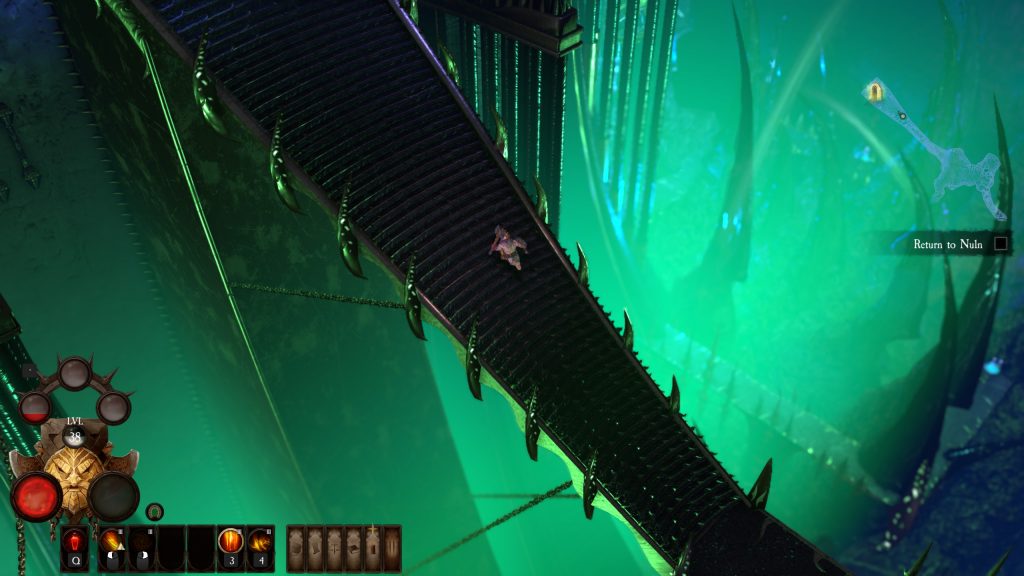
Screenshot: Warhammer Chaosbane
 Warhammer Chaosbane
Warhammer Chaosbane is here. Developed by Eko Software, makers of the
How to Survive Series, this was a hotly anticipated action role-playing game. Part
Vermintide, part
Diablo,
Chaosbane looked exactly like the type of game my friends and I could sink hundreds of hours into. Of course,
Warhammer video games don’t have the best track record, so I tempered my hype accordingly.
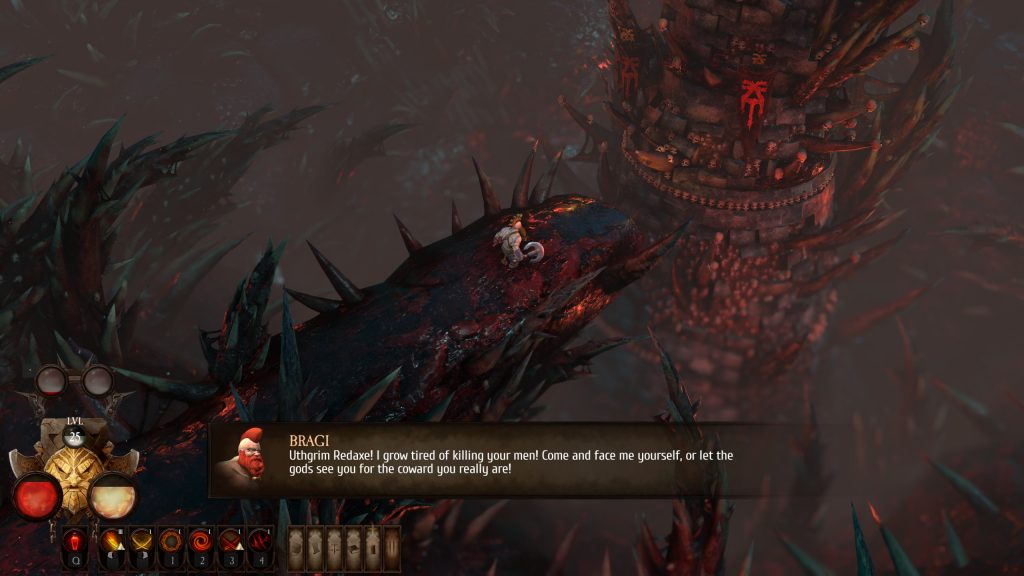
Screenshot: Warhammer Chaosbane
It’s about time that someone took the action role-playing game (ARPG) formula and applied it to the fantasy
Warhammer setting. There was
Warhammer 40,000: Inquisitor Martyr that was solidly ARPG, but despite my cursory enjoyment with it, it wasn’t a very polished game. I was pleasantly surprised when I started out as a Slayer Dwarf in
Chaosbane to discover that it looked and felt great to play.
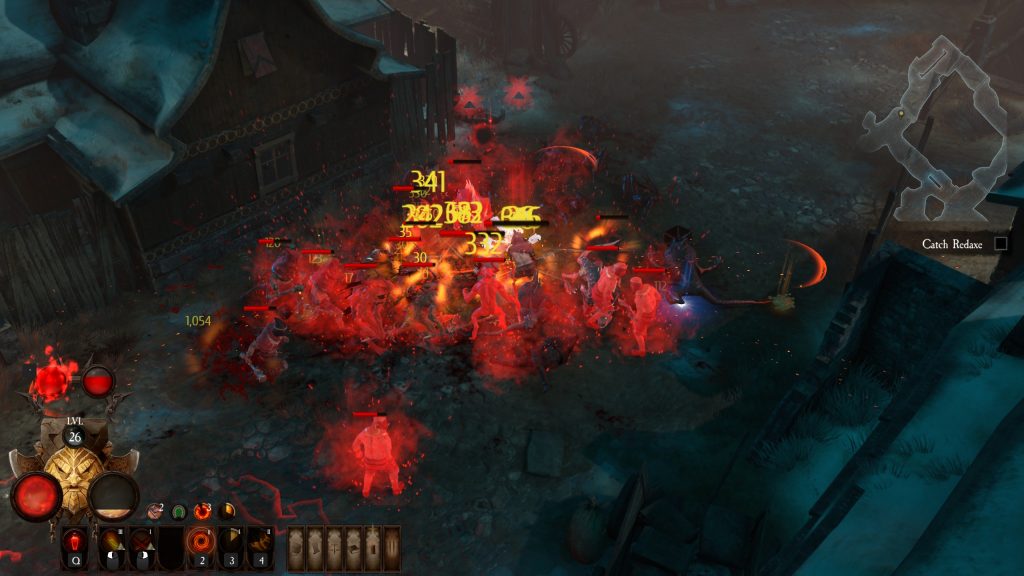
Screenshot: Warhammer Chaosbane
It’s fun in
Chaosbane to use your (eventually) crazy powerful abilities to smack down hordes of enemies in a single blow. I mean, that’s part of the appeal of ARPGs, and
Chaosbane’s abilities, movement, and combat are all fun. The Slayer has a particularly fun leap and whirlwind ability that I spent most of my time in my first playthrough using, and the high-elf mage’s teleport ability that allows him to travel forward short distances is implemented in a satisfactorily smooth way.
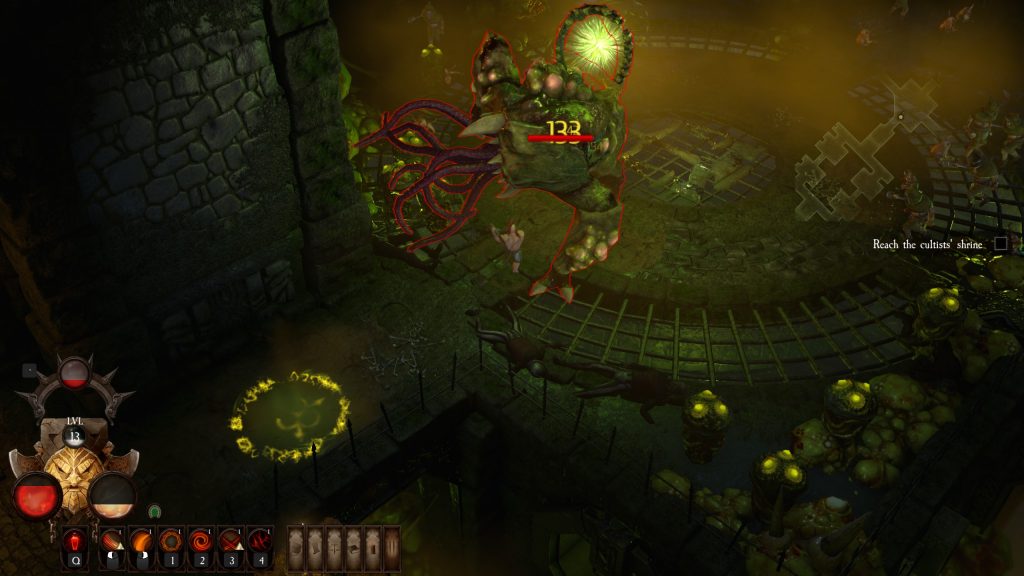
Screenshot: Warhammer Chaosbane
And that’s where it hit me:
Chaosbane isn’t just an ARPG, it’s literally a clone of
Diablo 3. That’s okay, as long as it’s done right.
Chaosbane is done well, but whether all of the pieces come together to be done “right” is up for debate.
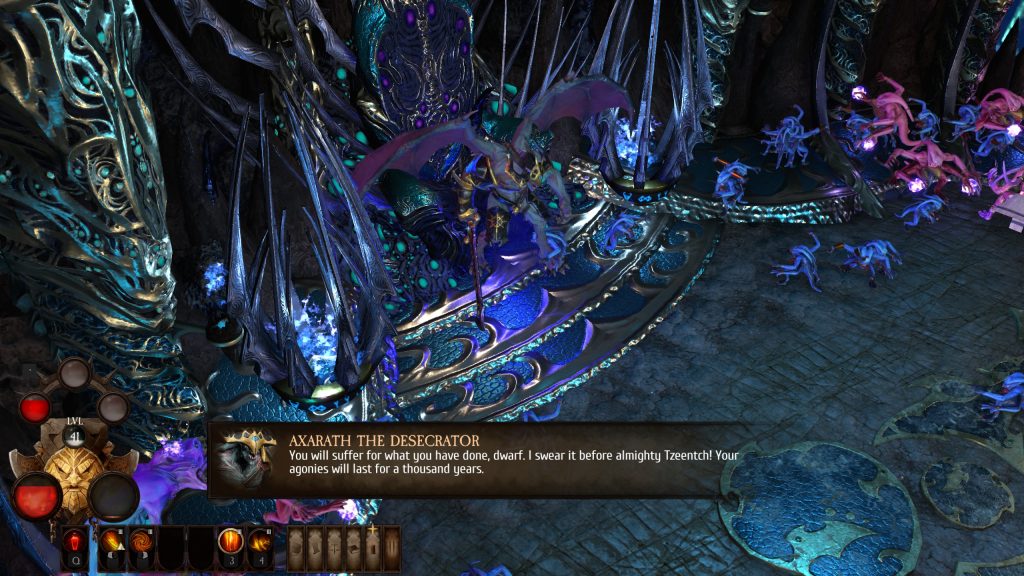
Screenshot: Warhammer Chaosbane
Chaosbane is
Diablo 3-like all the way down to the similar color and font of the damage numbers. Hell, even the first (of four) boss encounters reminded me of the Belial boss fight in
Diablo 3—the last boss was even sort of like the Diablo fight. Even some of the character classes seemed to be plucked from
Diablo 3.
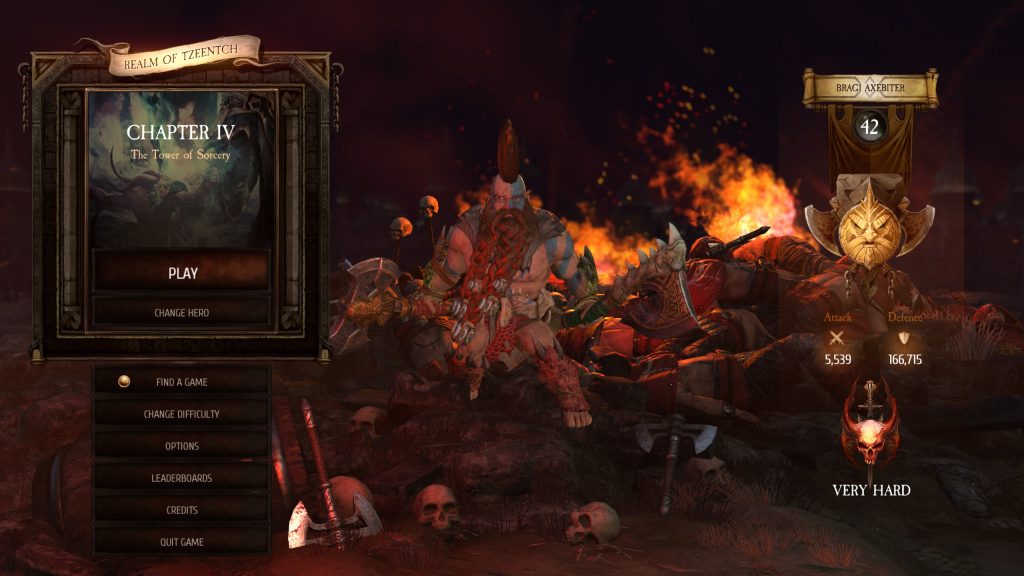
Screenshot: Warhammer Chaosbane
The character classes are exactly what you would think they would be. There’s a High Elf mage, who wields sword and sorcery, and reminds me a lot of
Diablo 3’s Wizard class. There is the Dwarf Slayer—mohawked, badass, but very much like the
Diablo 3 Barbarian class. The Wood Elf Waystalker is a ranged class that summons companions to fight at her side. The Bretonnian soldier is a melee class with an emphasis on defensive buffs, and crowd control debuffs.
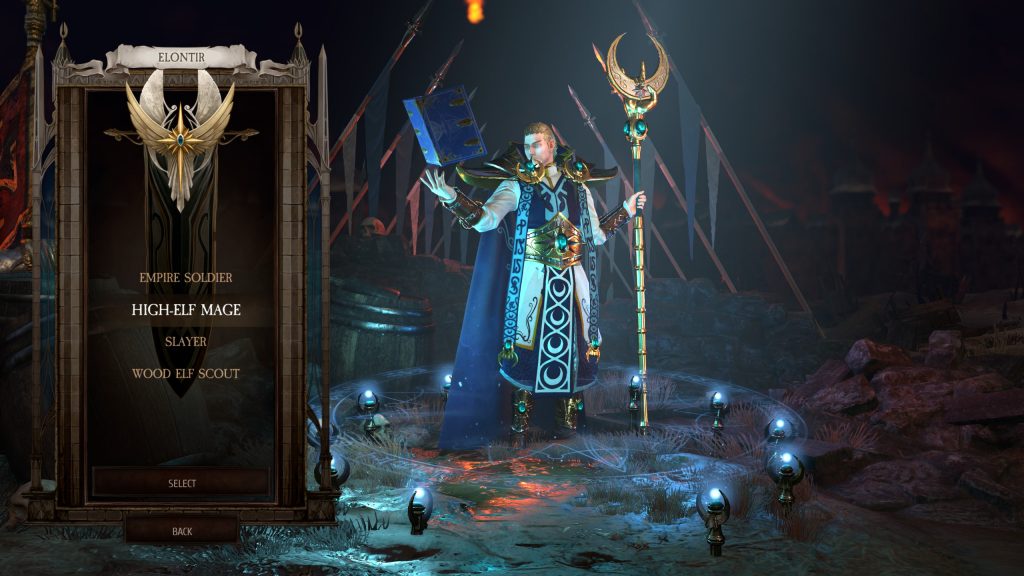
Screenshot: Warhammer Chaosbane
Despite the classes being suspiciously similar to
Diablo 3 classes, they are a lot of fun. At first, their abilities seem very pedestrian. But once you level up more, and use the upgraded version of abilities, the real fun starts to happen.
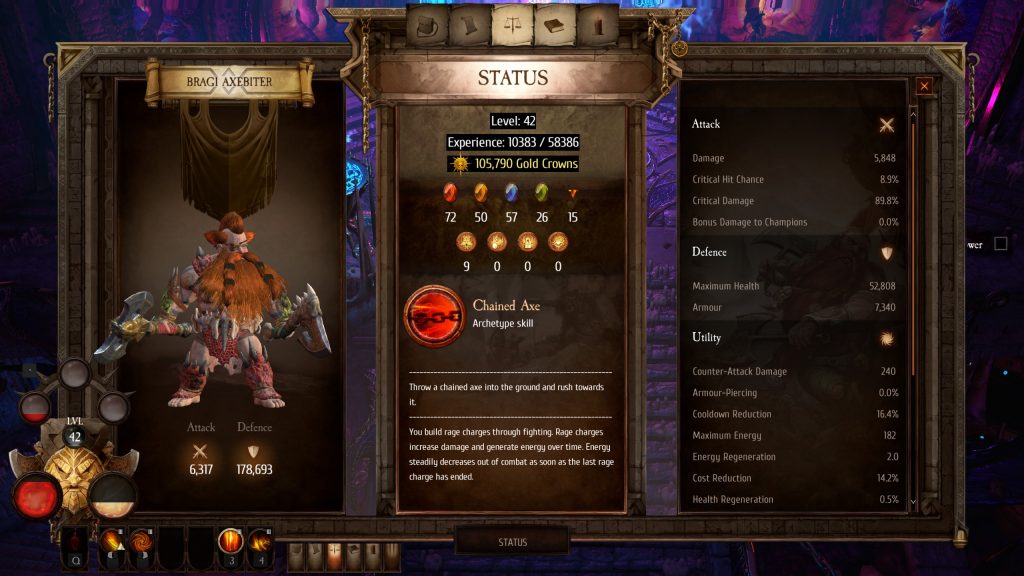
Screenshot: Warhammer Chaosbane
The skills that you can equip and use are determined by a point system. Depending on your level, you may only equip up to a certain amount of points in skills. The higher the tier the skill, the more expensive it is to equip it. I ended up not filling up my bar with skills, but instead taking only a couple of extremely powerful abilities. It’s an interesting system, and it could lead to some fun min-max opportunities—if that’s your thing.
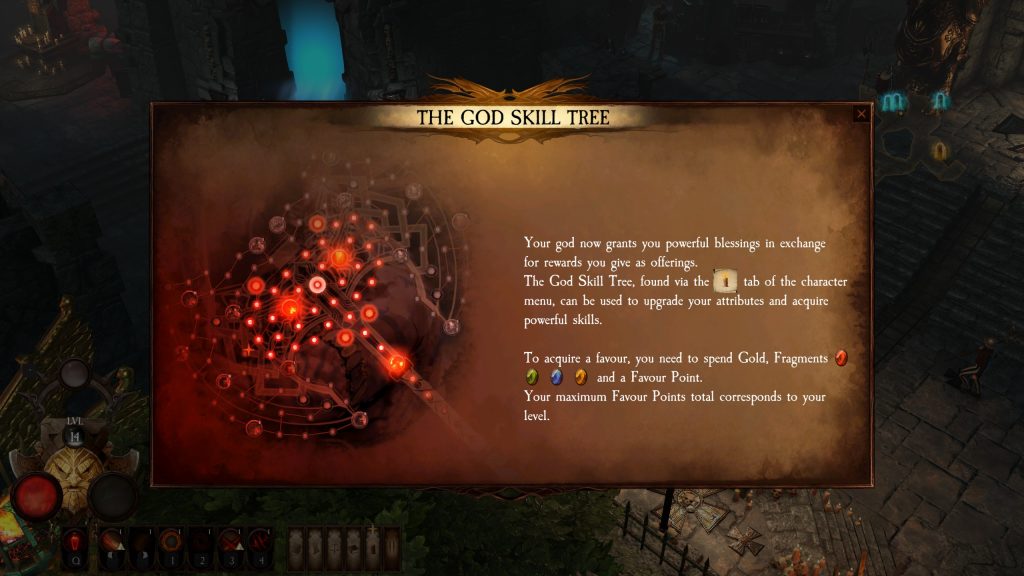
Screenshot: Warhammer Chaosbane
You can further upgrade your characters using a system similar to
Path of Exile's (though not nearly as complicated) that allows you to upgrade your characters using a spider-web of a skill tree. All of these uprades are incremental boosts to health, armor, etc, but sometimes you can get powerful passive or active “God abilities.”
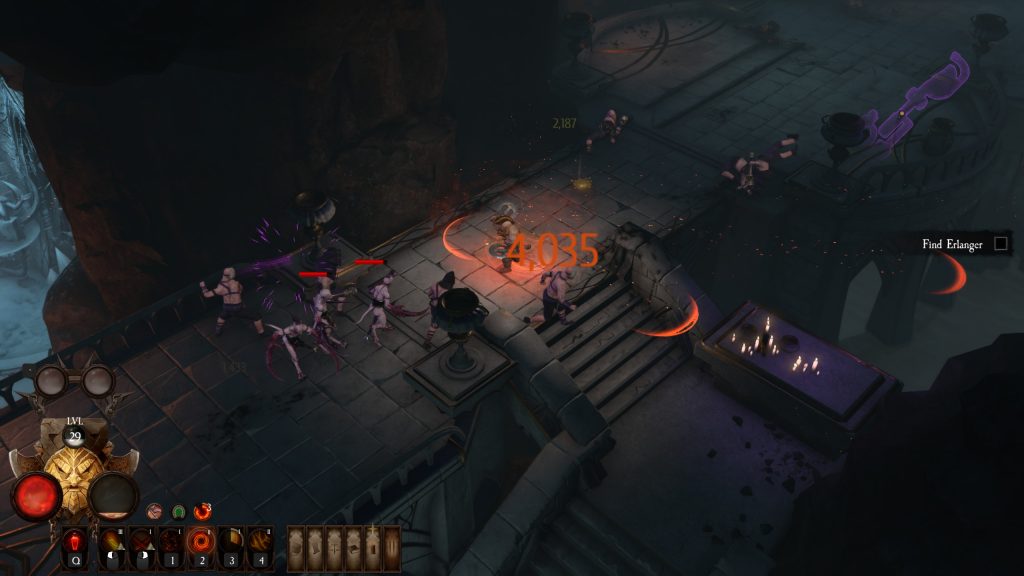
Screenshot: Warhammer Chaosbane
There is also a frenzy meter that, once filled, allows your character to perform extremely powerful attacks. These attacks can clear out rooms of enemies, or take down bosses extremely quickly.
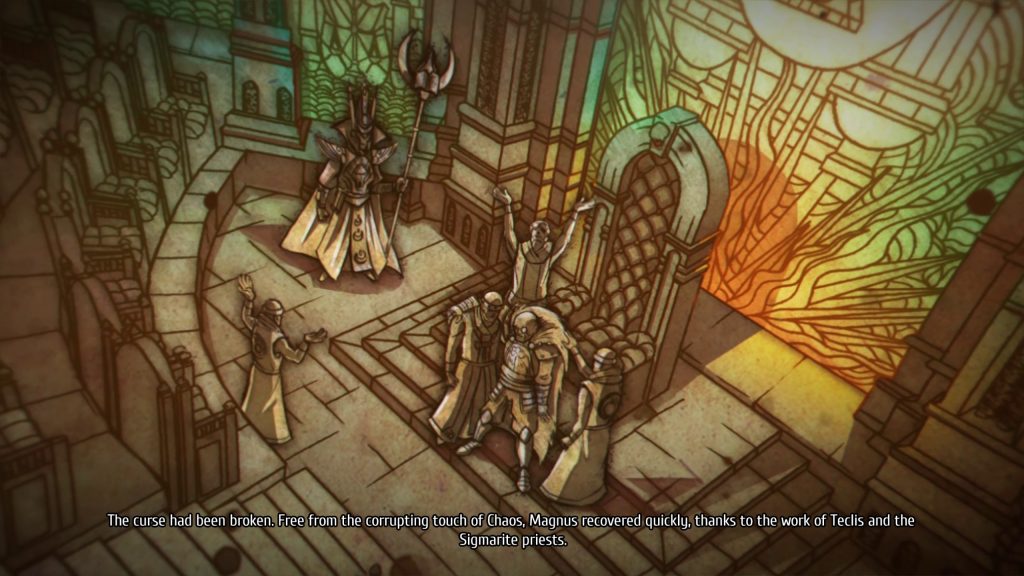
Screenshot: Warhammer Chaosbane
The setting and story are
Warhammer, but, despite the cool hand drawn style intro, the story is conveyed through mediocre voice acting in exposition dumps between objectives. I found myself skipping through most of these dialogue sections quickly, just to get back into the action.
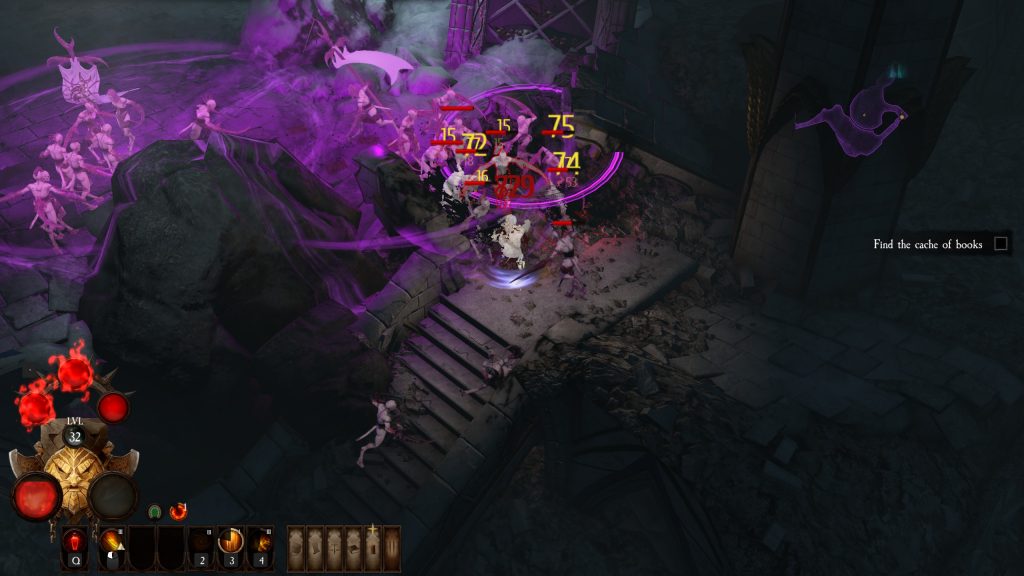
Screenshot: Warhammer Chaosbane
There are four acts in total that you will fight across, but moving through the world isn’t as epic as it is in other ARPGs. Each act is a hub, and you use this hub to access the different objectives. Usually, objectives consist of fighting through an area until you find something, or kill something.
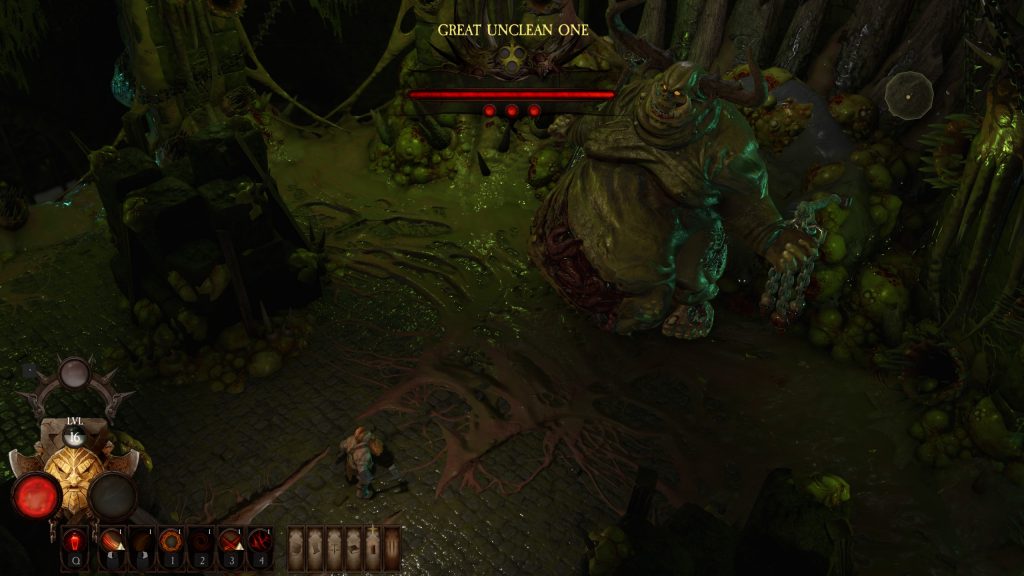
Screenshot: Warhammer Chaosbane
There are bosses at the end of each of these acts—and while they’re cool visually, the fights themselves feel sort of tedious. Each boss has a health bar that you must deplete three times before the boss is completely dead. If you fail at any point, you have to fight the entire encounter again.
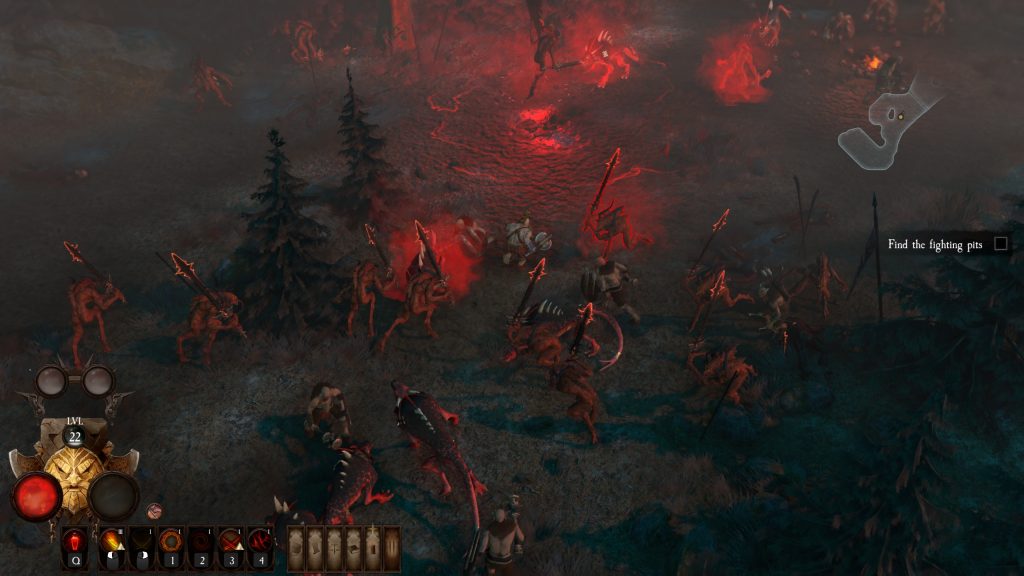
Screenshot: Warhammer Chaosbane
Death in general isn’t that inconvenient—you can choose to restart an area, or respawn at the expense of some of your currency. There doesn’t seem to be a Hardcore Mode that I could find, so if you’re a thrill seeker hoping for that feature, I didn’t find a way to access it--which is a bummer.
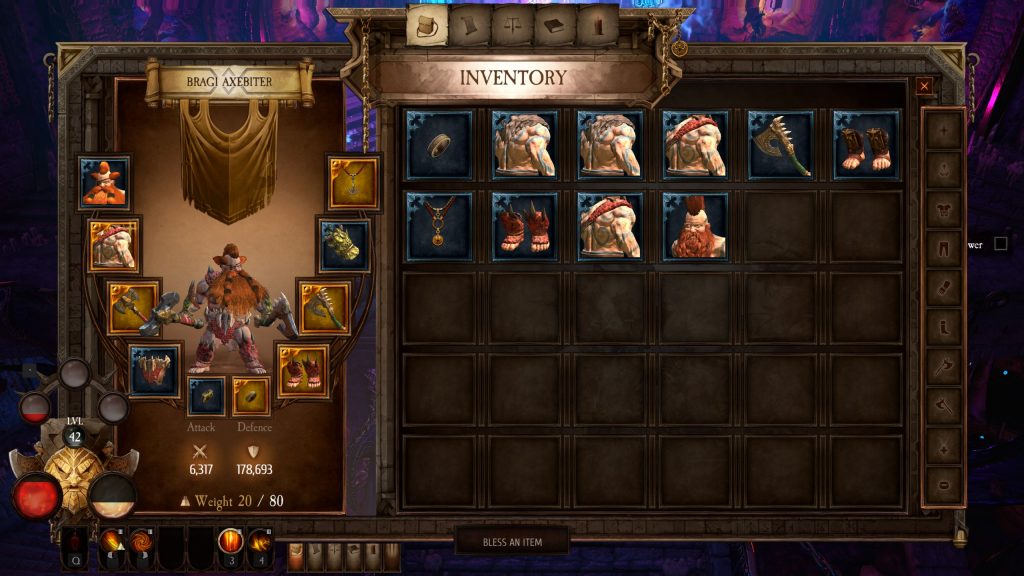
Screenshot: Warhammer Chaosbane
The gear in ARPGs is one of the most important parts. Unfortunately, the gear in
Chaosbane is just serviceable—it does what it’s supposed to, and nothing else that seems overly exciting. You have your normal tiers of items—common, uncommon, rare, etc., though I’m not entirely sure what exact name
Chaosbane calls them, it’s all the same from other ARPGs if you’ve played any before.
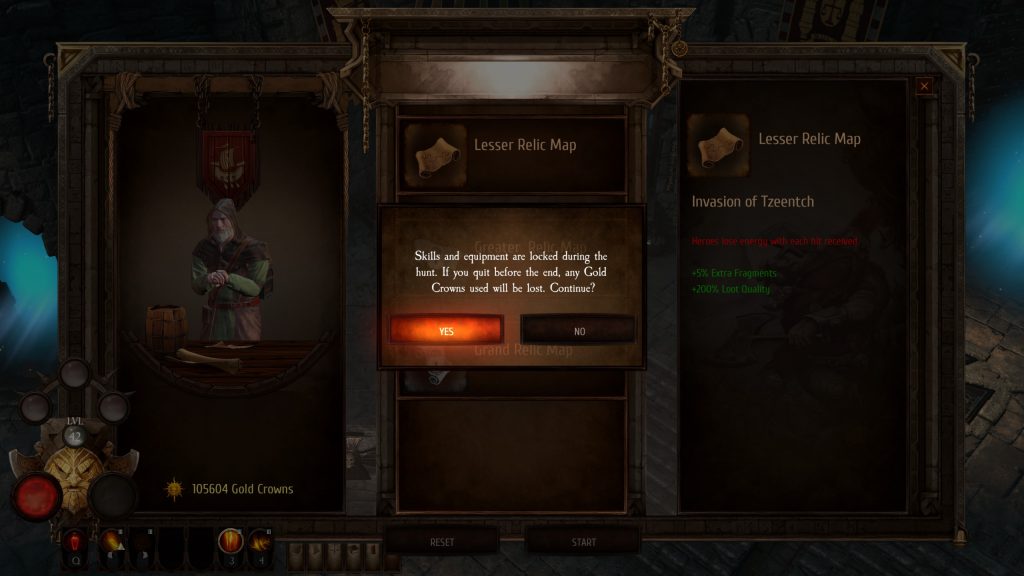
Screenshot: Warhammer Chaosbane
In the end,
Warhammer Chaosbane is really just a Diablo 3 clone, right down to the challenges within the “Expedition” levels, which just serve as an analogue to Diablo 3’s “Adventures.” You can even pay to participate in certain encounters, which remind me of Diablo 3’s rift system—but in an extremely rudimentary way. These serve as a sort of “end game” experience, along with Boss Rush, which is where you can choose to fight a specific boss.
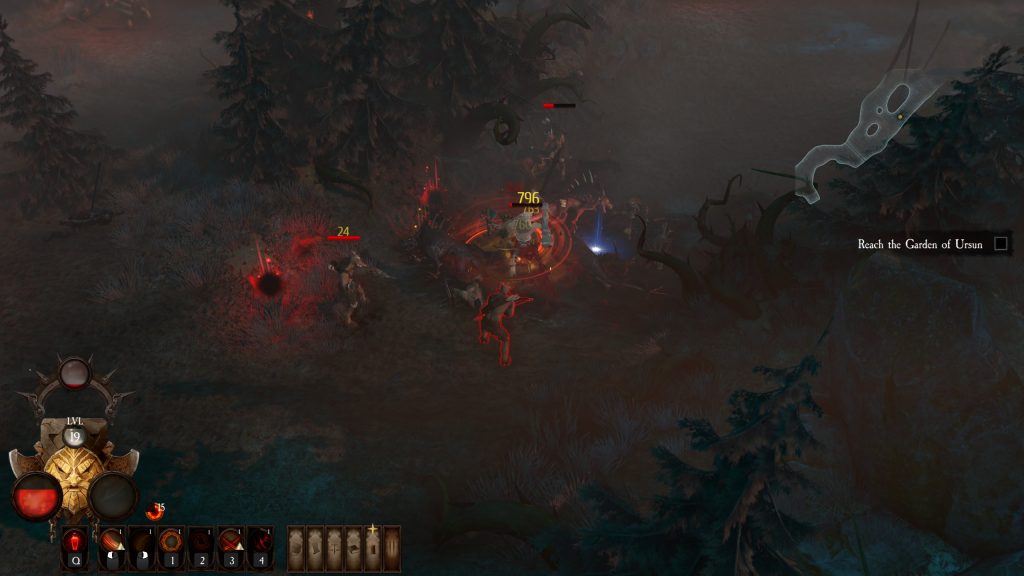
Screenshot: Warhammer Chaosbane
Despite how crisp the controls are, the entire package--especially the first few hours—feels extremely mediocre and generic.
Chaosbane would have done well to endear itself to players in those first few hours. Instead, you have to slog through some pretty by-the-numbers ARPG encounters to get to your characters' real fun abilities.
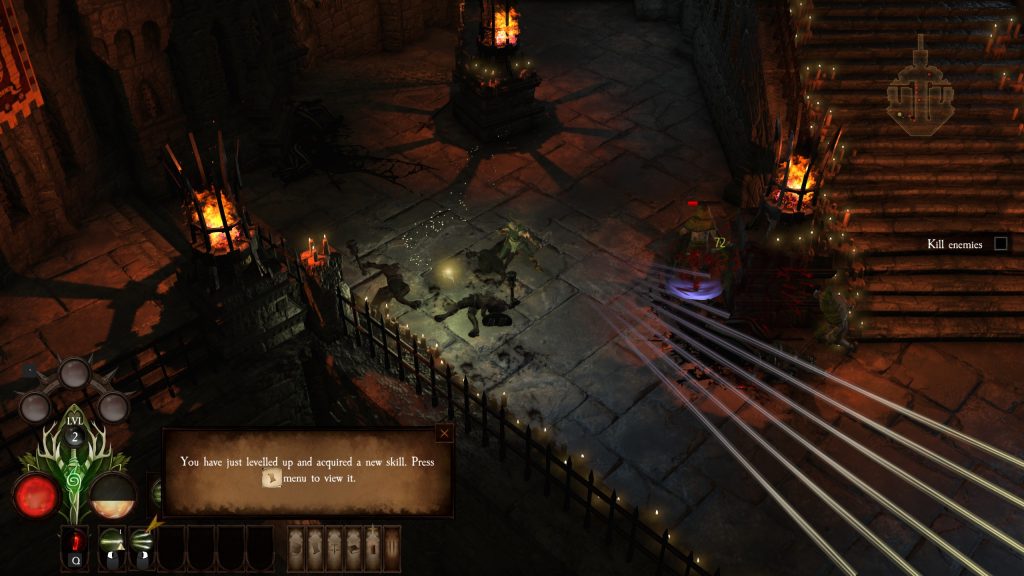
Screenshot: Warhammer Chaosbane
Even the enemies you fight in
Chaobane feel generic. They’re your normal projectile throwing, or charging mobs. These denizens of chaos had little personality, though, and serve only as axe and sword fodder for your adventuring team.
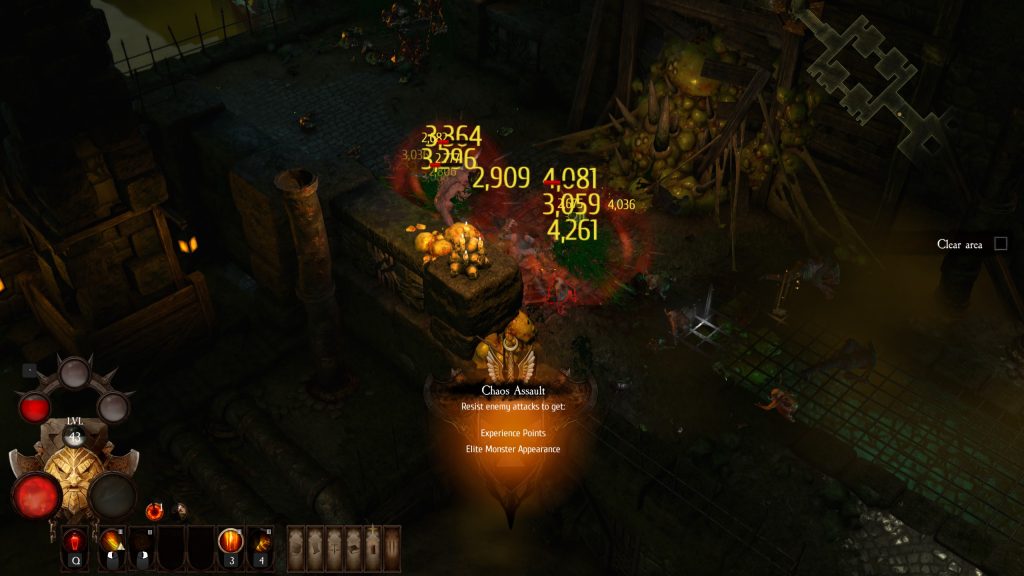
Screenshot: Warhammer Chaosbane
You can play this in full multiplayer, and it’s probably even more fun that way. Unfortunately, most of my colleagues and friends opted out of the
Warhammer Chaosbane experience.
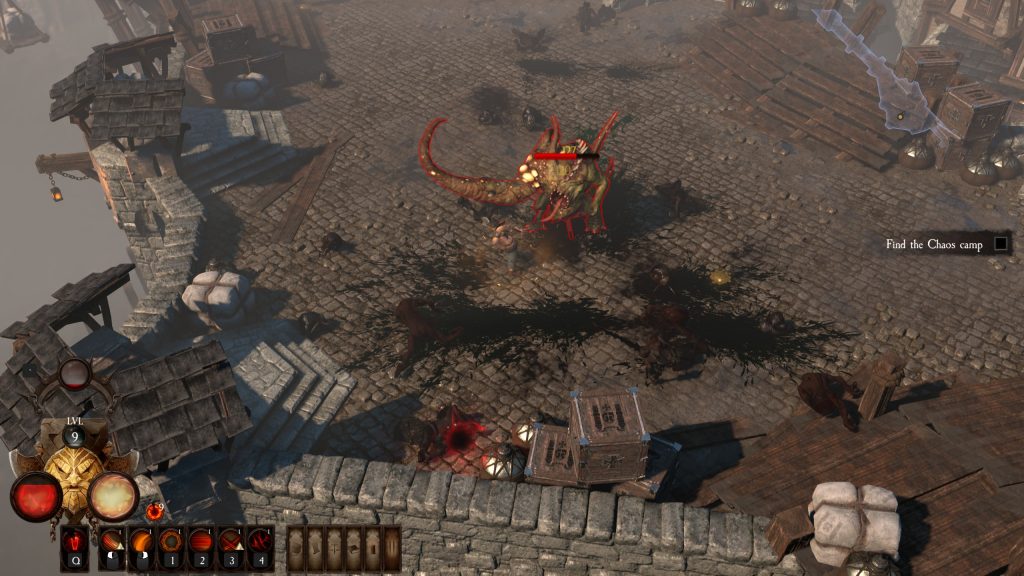
Screenshot: Warhammer Chaosbane
Chaosbane is not a bad game, it’s just not a great game—though it really has the potential to be. The smooth combat and classes are interesting. The loot isn’t the greatest, and the “endgame” is as tedious as you would expect from an ARPG, but your mileage may vary.
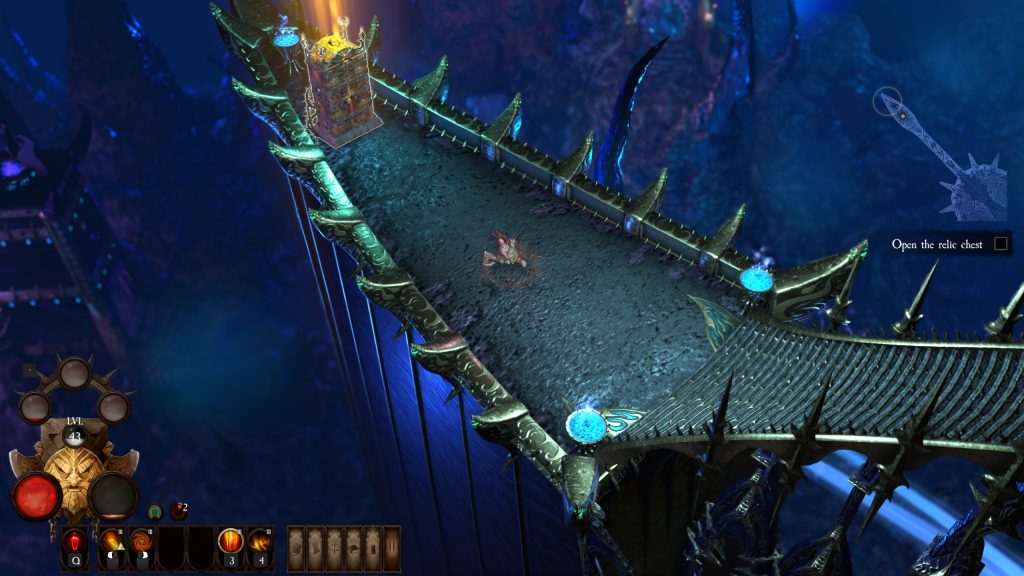
Screenshot: Warhammer Chaosbane
But there’s one real caveat here: why get
Chaosbane when
Diablo 3 has been out for years, is polished to hell, and is clearly the superior game? If you want more
Diablo 3 then
Chaosbane almost serves as an unofficial expansion pack. Similarly, if you absolutely need to play an ARPG set in the fantasy
Warhammer universe, this will scratch that itch.
If you like the video game, tabletop, or other technology content that Third Coast Review has to offer, consider donating to our Patreon. We are the only publication in Chicago that regularly reviews video games, and we cover lots of local Chicago-based events and more. If you want to contribute to our coverage of Chicago’s video game scene (and more) please consider becoming a patron. Your support enables us to continue to provide this type of content and more. Patreon.com/3CR
 Screenshot: Warhammer Chaosbane
Screenshot: Warhammer Chaosbane
 Warhammer Chaosbane is here. Developed by Eko Software, makers of the How to Survive Series, this was a hotly anticipated action role-playing game. Part Vermintide, part Diablo, Chaosbane looked exactly like the type of game my friends and I could sink hundreds of hours into. Of course, Warhammer video games don’t have the best track record, so I tempered my hype accordingly.
Warhammer Chaosbane is here. Developed by Eko Software, makers of the How to Survive Series, this was a hotly anticipated action role-playing game. Part Vermintide, part Diablo, Chaosbane looked exactly like the type of game my friends and I could sink hundreds of hours into. Of course, Warhammer video games don’t have the best track record, so I tempered my hype accordingly.
 Screenshot: Warhammer Chaosbane
It’s about time that someone took the action role-playing game (ARPG) formula and applied it to the fantasy Warhammer setting. There was Warhammer 40,000: Inquisitor Martyr that was solidly ARPG, but despite my cursory enjoyment with it, it wasn’t a very polished game. I was pleasantly surprised when I started out as a Slayer Dwarf in Chaosbane to discover that it looked and felt great to play.
Screenshot: Warhammer Chaosbane
It’s about time that someone took the action role-playing game (ARPG) formula and applied it to the fantasy Warhammer setting. There was Warhammer 40,000: Inquisitor Martyr that was solidly ARPG, but despite my cursory enjoyment with it, it wasn’t a very polished game. I was pleasantly surprised when I started out as a Slayer Dwarf in Chaosbane to discover that it looked and felt great to play.
 Screenshot: Warhammer Chaosbane
It’s fun in Chaosbane to use your (eventually) crazy powerful abilities to smack down hordes of enemies in a single blow. I mean, that’s part of the appeal of ARPGs, and Chaosbane’s abilities, movement, and combat are all fun. The Slayer has a particularly fun leap and whirlwind ability that I spent most of my time in my first playthrough using, and the high-elf mage’s teleport ability that allows him to travel forward short distances is implemented in a satisfactorily smooth way.
Screenshot: Warhammer Chaosbane
It’s fun in Chaosbane to use your (eventually) crazy powerful abilities to smack down hordes of enemies in a single blow. I mean, that’s part of the appeal of ARPGs, and Chaosbane’s abilities, movement, and combat are all fun. The Slayer has a particularly fun leap and whirlwind ability that I spent most of my time in my first playthrough using, and the high-elf mage’s teleport ability that allows him to travel forward short distances is implemented in a satisfactorily smooth way.
 Screenshot: Warhammer Chaosbane
And that’s where it hit me: Chaosbane isn’t just an ARPG, it’s literally a clone of Diablo 3. That’s okay, as long as it’s done right. Chaosbane is done well, but whether all of the pieces come together to be done “right” is up for debate.
Screenshot: Warhammer Chaosbane
And that’s where it hit me: Chaosbane isn’t just an ARPG, it’s literally a clone of Diablo 3. That’s okay, as long as it’s done right. Chaosbane is done well, but whether all of the pieces come together to be done “right” is up for debate.
 Screenshot: Warhammer Chaosbane
Chaosbane is Diablo 3-like all the way down to the similar color and font of the damage numbers. Hell, even the first (of four) boss encounters reminded me of the Belial boss fight in Diablo 3—the last boss was even sort of like the Diablo fight. Even some of the character classes seemed to be plucked from Diablo 3.
Screenshot: Warhammer Chaosbane
Chaosbane is Diablo 3-like all the way down to the similar color and font of the damage numbers. Hell, even the first (of four) boss encounters reminded me of the Belial boss fight in Diablo 3—the last boss was even sort of like the Diablo fight. Even some of the character classes seemed to be plucked from Diablo 3.
 Screenshot: Warhammer Chaosbane
The character classes are exactly what you would think they would be. There’s a High Elf mage, who wields sword and sorcery, and reminds me a lot of Diablo 3’s Wizard class. There is the Dwarf Slayer—mohawked, badass, but very much like the Diablo 3 Barbarian class. The Wood Elf Waystalker is a ranged class that summons companions to fight at her side. The Bretonnian soldier is a melee class with an emphasis on defensive buffs, and crowd control debuffs.
Screenshot: Warhammer Chaosbane
The character classes are exactly what you would think they would be. There’s a High Elf mage, who wields sword and sorcery, and reminds me a lot of Diablo 3’s Wizard class. There is the Dwarf Slayer—mohawked, badass, but very much like the Diablo 3 Barbarian class. The Wood Elf Waystalker is a ranged class that summons companions to fight at her side. The Bretonnian soldier is a melee class with an emphasis on defensive buffs, and crowd control debuffs.
 Screenshot: Warhammer Chaosbane
Despite the classes being suspiciously similar to Diablo 3 classes, they are a lot of fun. At first, their abilities seem very pedestrian. But once you level up more, and use the upgraded version of abilities, the real fun starts to happen.
Screenshot: Warhammer Chaosbane
Despite the classes being suspiciously similar to Diablo 3 classes, they are a lot of fun. At first, their abilities seem very pedestrian. But once you level up more, and use the upgraded version of abilities, the real fun starts to happen.
 Screenshot: Warhammer Chaosbane
The skills that you can equip and use are determined by a point system. Depending on your level, you may only equip up to a certain amount of points in skills. The higher the tier the skill, the more expensive it is to equip it. I ended up not filling up my bar with skills, but instead taking only a couple of extremely powerful abilities. It’s an interesting system, and it could lead to some fun min-max opportunities—if that’s your thing.
Screenshot: Warhammer Chaosbane
The skills that you can equip and use are determined by a point system. Depending on your level, you may only equip up to a certain amount of points in skills. The higher the tier the skill, the more expensive it is to equip it. I ended up not filling up my bar with skills, but instead taking only a couple of extremely powerful abilities. It’s an interesting system, and it could lead to some fun min-max opportunities—if that’s your thing.
 Screenshot: Warhammer Chaosbane
You can further upgrade your characters using a system similar to Path of Exile's (though not nearly as complicated) that allows you to upgrade your characters using a spider-web of a skill tree. All of these uprades are incremental boosts to health, armor, etc, but sometimes you can get powerful passive or active “God abilities.”
Screenshot: Warhammer Chaosbane
You can further upgrade your characters using a system similar to Path of Exile's (though not nearly as complicated) that allows you to upgrade your characters using a spider-web of a skill tree. All of these uprades are incremental boosts to health, armor, etc, but sometimes you can get powerful passive or active “God abilities.”
 Screenshot: Warhammer Chaosbane
There is also a frenzy meter that, once filled, allows your character to perform extremely powerful attacks. These attacks can clear out rooms of enemies, or take down bosses extremely quickly.
Screenshot: Warhammer Chaosbane
There is also a frenzy meter that, once filled, allows your character to perform extremely powerful attacks. These attacks can clear out rooms of enemies, or take down bosses extremely quickly.
 Screenshot: Warhammer Chaosbane
The setting and story are Warhammer, but, despite the cool hand drawn style intro, the story is conveyed through mediocre voice acting in exposition dumps between objectives. I found myself skipping through most of these dialogue sections quickly, just to get back into the action.
Screenshot: Warhammer Chaosbane
The setting and story are Warhammer, but, despite the cool hand drawn style intro, the story is conveyed through mediocre voice acting in exposition dumps between objectives. I found myself skipping through most of these dialogue sections quickly, just to get back into the action.
 Screenshot: Warhammer Chaosbane
There are four acts in total that you will fight across, but moving through the world isn’t as epic as it is in other ARPGs. Each act is a hub, and you use this hub to access the different objectives. Usually, objectives consist of fighting through an area until you find something, or kill something.
Screenshot: Warhammer Chaosbane
There are four acts in total that you will fight across, but moving through the world isn’t as epic as it is in other ARPGs. Each act is a hub, and you use this hub to access the different objectives. Usually, objectives consist of fighting through an area until you find something, or kill something.
 Screenshot: Warhammer Chaosbane
There are bosses at the end of each of these acts—and while they’re cool visually, the fights themselves feel sort of tedious. Each boss has a health bar that you must deplete three times before the boss is completely dead. If you fail at any point, you have to fight the entire encounter again.
Screenshot: Warhammer Chaosbane
There are bosses at the end of each of these acts—and while they’re cool visually, the fights themselves feel sort of tedious. Each boss has a health bar that you must deplete three times before the boss is completely dead. If you fail at any point, you have to fight the entire encounter again.
 Screenshot: Warhammer Chaosbane
Death in general isn’t that inconvenient—you can choose to restart an area, or respawn at the expense of some of your currency. There doesn’t seem to be a Hardcore Mode that I could find, so if you’re a thrill seeker hoping for that feature, I didn’t find a way to access it--which is a bummer.
Screenshot: Warhammer Chaosbane
Death in general isn’t that inconvenient—you can choose to restart an area, or respawn at the expense of some of your currency. There doesn’t seem to be a Hardcore Mode that I could find, so if you’re a thrill seeker hoping for that feature, I didn’t find a way to access it--which is a bummer.
 Screenshot: Warhammer Chaosbane
The gear in ARPGs is one of the most important parts. Unfortunately, the gear in Chaosbane is just serviceable—it does what it’s supposed to, and nothing else that seems overly exciting. You have your normal tiers of items—common, uncommon, rare, etc., though I’m not entirely sure what exact name Chaosbane calls them, it’s all the same from other ARPGs if you’ve played any before.
Screenshot: Warhammer Chaosbane
The gear in ARPGs is one of the most important parts. Unfortunately, the gear in Chaosbane is just serviceable—it does what it’s supposed to, and nothing else that seems overly exciting. You have your normal tiers of items—common, uncommon, rare, etc., though I’m not entirely sure what exact name Chaosbane calls them, it’s all the same from other ARPGs if you’ve played any before.
 Screenshot: Warhammer Chaosbane
In the end, Warhammer Chaosbane is really just a Diablo 3 clone, right down to the challenges within the “Expedition” levels, which just serve as an analogue to Diablo 3’s “Adventures.” You can even pay to participate in certain encounters, which remind me of Diablo 3’s rift system—but in an extremely rudimentary way. These serve as a sort of “end game” experience, along with Boss Rush, which is where you can choose to fight a specific boss.
Screenshot: Warhammer Chaosbane
In the end, Warhammer Chaosbane is really just a Diablo 3 clone, right down to the challenges within the “Expedition” levels, which just serve as an analogue to Diablo 3’s “Adventures.” You can even pay to participate in certain encounters, which remind me of Diablo 3’s rift system—but in an extremely rudimentary way. These serve as a sort of “end game” experience, along with Boss Rush, which is where you can choose to fight a specific boss.
 Screenshot: Warhammer Chaosbane
Despite how crisp the controls are, the entire package--especially the first few hours—feels extremely mediocre and generic. Chaosbane would have done well to endear itself to players in those first few hours. Instead, you have to slog through some pretty by-the-numbers ARPG encounters to get to your characters' real fun abilities.
Screenshot: Warhammer Chaosbane
Despite how crisp the controls are, the entire package--especially the first few hours—feels extremely mediocre and generic. Chaosbane would have done well to endear itself to players in those first few hours. Instead, you have to slog through some pretty by-the-numbers ARPG encounters to get to your characters' real fun abilities.
 Screenshot: Warhammer Chaosbane
Even the enemies you fight in Chaobane feel generic. They’re your normal projectile throwing, or charging mobs. These denizens of chaos had little personality, though, and serve only as axe and sword fodder for your adventuring team.
Screenshot: Warhammer Chaosbane
Even the enemies you fight in Chaobane feel generic. They’re your normal projectile throwing, or charging mobs. These denizens of chaos had little personality, though, and serve only as axe and sword fodder for your adventuring team.
 Screenshot: Warhammer Chaosbane
You can play this in full multiplayer, and it’s probably even more fun that way. Unfortunately, most of my colleagues and friends opted out of the Warhammer Chaosbane experience.
Screenshot: Warhammer Chaosbane
You can play this in full multiplayer, and it’s probably even more fun that way. Unfortunately, most of my colleagues and friends opted out of the Warhammer Chaosbane experience.
 Screenshot: Warhammer Chaosbane
Chaosbane is not a bad game, it’s just not a great game—though it really has the potential to be. The smooth combat and classes are interesting. The loot isn’t the greatest, and the “endgame” is as tedious as you would expect from an ARPG, but your mileage may vary.
Screenshot: Warhammer Chaosbane
Chaosbane is not a bad game, it’s just not a great game—though it really has the potential to be. The smooth combat and classes are interesting. The loot isn’t the greatest, and the “endgame” is as tedious as you would expect from an ARPG, but your mileage may vary.
 Screenshot: Warhammer Chaosbane
But there’s one real caveat here: why get Chaosbane when Diablo 3 has been out for years, is polished to hell, and is clearly the superior game? If you want more Diablo 3 then Chaosbane almost serves as an unofficial expansion pack. Similarly, if you absolutely need to play an ARPG set in the fantasy Warhammer universe, this will scratch that itch.
If you like the video game, tabletop, or other technology content that Third Coast Review has to offer, consider donating to our Patreon. We are the only publication in Chicago that regularly reviews video games, and we cover lots of local Chicago-based events and more. If you want to contribute to our coverage of Chicago’s video game scene (and more) please consider becoming a patron. Your support enables us to continue to provide this type of content and more. Patreon.com/3CR
Screenshot: Warhammer Chaosbane
But there’s one real caveat here: why get Chaosbane when Diablo 3 has been out for years, is polished to hell, and is clearly the superior game? If you want more Diablo 3 then Chaosbane almost serves as an unofficial expansion pack. Similarly, if you absolutely need to play an ARPG set in the fantasy Warhammer universe, this will scratch that itch.
If you like the video game, tabletop, or other technology content that Third Coast Review has to offer, consider donating to our Patreon. We are the only publication in Chicago that regularly reviews video games, and we cover lots of local Chicago-based events and more. If you want to contribute to our coverage of Chicago’s video game scene (and more) please consider becoming a patron. Your support enables us to continue to provide this type of content and more. Patreon.com/3CR
